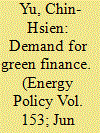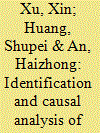|
|
|
Sort Order |
|
|
|
Items / Page
|
|
|
|
|
|
|
| Srl | Item |
| 1 |
ID:
178812


|
|
|
|
|
| Summary/Abstract |
The UK government's policy of support for shale gas extraction ended in November 2019 with the imposition of a moratorium on fracking (hydraulic fracturing) in England, and an admission that the policies to manage induced seismicity were insufficient. However, ambiguities remain regarding its scope, despite attempts at clarification. The concept of fracking to improve hydrocarbon production has evolved from defining a specific engineering process, using high volumes of water, to encompass other ‘unconventional’ methods to achieve the same end. We resolve the various definitions in a scientific, technical, regulatory and legislative context, robustly define unconventional extraction methods (circumventing the need to identify and quantify the various technologies available), and advocate the precautionary principle in drafting and interpreting regulations. Policy should be driven by the engineering of the bulk physical characteristics of the target rock, rather than by the current definitions based on injected fluid volume. To meet climate change concerns, the moratorium should be converted into a ban. In the interim, we argue that, in order to comply with the government's policy of ensuring safe and sustainable operations, the moratorium should be extended to all well stimulation treatments for unconventional hydrocarbon extraction, including acid stimulation.
|
|
|
|
|
|
|
|
|
|
|
|
|
|
|
|
| 2 |
ID:
178840


|
|
|
|
|
| Summary/Abstract |
Recent interest in the Levelised Cost of Energy (LCOE) for offshore wind has led to considerable media coverage of this topic. The paper to which this article refers provides some useful insights, but the authors are concerned that their findings are being misreported and misinterpreted. Specifically, some of the media coverage appears to misunderstand or disregard the acknowledged limitations of the paper, citing it to support contentions regarding the likely trajectory of costs for offshore wind farms. This research note addresses some of these issues and urges caution in use of the original paper’s findings. This new research note recapitulates the main themes of the original paper and directly addresses the areas where its findings have apparently been misunderstood. It concludes with a restated and reinforced warning that the analysis and projection of historic costs in offshore wind, or indeed in any fast-developing technology sector, should be undertaken with extreme caution when used to consider future cost trends.
|
|
|
|
|
|
|
|
|
|
|
|
|
|
|
|
| 3 |
ID:
178818


|
|
|
|
|
| Summary/Abstract |
Market efficiency is distorted when retailers are unwilling to pass on changes in wholesale costs or the price of oil (as a major production input cost) to motorists. Existing approaches to measuring pass-through parameters may obscure such behaviour because of the use of fixed-parameter models and/or aggregated price data across different locations and brands over time. We contribute to the literature by examining if there is a mismatch between wholesale and retail petrol prices across different brands supplying unleaded petrol within the same geographical location. To do so, we examine the effects of upstream shocks, arising from changes in oil or wholesale petrol prices, on the retail petrol prices of 672 stations in Sydney, Australia's largest city. We find that the pass-through parameters are significantly lower for stations with fewer competitors in their immediate proximity. When there are fewer than 13 petrol stations within a 5-km radius, or 33 stations within 10 km, irrespective of their brand, they become increasingly less responsive to changes in the wholesale petrol price or the price of crude oil. Our findings enhance market transparency and provide regulators with a rule of thumb that allows them to monitor the unleaded petrol market more effectively.
|
|
|
|
|
|
|
|
|
|
|
|
|
|
|
|
| 4 |
ID:
178819


|
|
|
|
|
| Summary/Abstract |
Motivated by the lack of research on price efficiency dynamics of green bonds and the impact of the COVID-19 on the pricing of fixed-income securities, this study investigates the comparative efficiency of green and conventional bond markets pre- and during the COVID-19 pandemic applying asymmetric multifractal analysis. Specifically, the multifractal scaling behaviour is examined separately during upward and downward trends in bond markets using the asymmetric multifractal detrended fluctuation analysis (A-MF-DFA) approach. The empirical findings confirm the presence of asymmetric multifractality in the green and traditional bond markets. Not surprisingly, inefficiency in both bond markets significantly escalated during the COVID-19 outbreak. Furthermore, our results indicate a higher level of efficiency of the conventional bond market over the full sample period. However, the green bond market is more efficient during a black swan event, such as the COVID-19 global pandemic, showing the potential of green bonds to become an effective diversifier for investors in traditional assets in times of extreme market turmoil. The results of the study can have important implications for investors and policymakers.
|
|
|
|
|
|
|
|
|
|
|
|
|
|
|
|
| 5 |
ID:
178813


|
|
|
|
|
| Summary/Abstract |
In the context of increasing renewable energy penetration in energy systems, demand response is acknowledged as a solution to guarantee grid stability and security of supply. Direct control of appliances by utilities, however, may lead to user dissatisfaction and disengagement via overrides. The present study, based on data from 6,389 connected thermostats in North America in the summer of 2019, investigates users' thermostat overriding behavior during demand response events targeting their air conditioners. An average event in this dataset was triggered around 3 p.m. and lasted three hours. The overall override rate was 12.9%. Overrides critically affected power usage during an event, with the share of the expected power demand reduction missed due to overrides being of the same order of magnitude as the override rate. In a decision tree analysis, the override rate showed to be particularly affected by occupants' habitual setpoint change frequency, outdoor temperature, event duration, and occupants’ previous experience with demand response. Even though the dataset is not representative of all types of demand response events, this study highlights the potential lying in connected thermostat data for utilities to design tailored demand response events with an increased success rate and a smaller impact on occupant comfort.
|
|
|
|
|
|
|
|
|
|
|
|
|
|
|
|
| 6 |
ID:
178842


|
|
|
|
|
| Summary/Abstract |
This paper investigates the effects of financing constraints on prompting green innovations using a sample of Chinese listed firms in the period 2001–2017. Also, we explore how green finance policies resolve financing constraints of firms to green innovation. The capability of green innovation is found to be impaired when firms face higher financing constraints, and privately owned enterprises tend to be more vulnerable than state-owned ones in this regard. Although green finance policies can effectively ease financing restraints on green innovation overall, green credits are less likely to be available to privately owned enterprises. However, these enterprises which are deeply affected by financing constraints have relatively high innovation capabilities. We suggest the government to provide more supports to privately owned enterprises for investing in green projects. Further, both financial institutions and privately owned enterprises should be required to disclose more information on green credits and green projects, respectively. In addition, the China Banking Regulatory Commission should design a synthetic mechanism for evaluating green performance.
|
|
|
|
|
|
|
|
|
|
|
|
|
|
|
|
| 7 |
ID:
178823


|
|
|
|
|
| Summary/Abstract |
Our paper critically assesses the trajectories of nuclear energy policy-making in Taiwan and South Korea through the lens of state-led democratic innovation. Nuclear energy is as controversial as the associated decision-making highly political, raising concerns with democratic participation. Generally, deliberative polls and referenda are considered more bottom-up and grassroots approaches to resolving complex energy issues. In Taiwan and South Korea, however, the state plays a key role in deciding what issues and decisions should be debated, and exercises control over the interpretation of the results. The strong state and centralised decision-making over energy policy means the processes in Taiwan and Korea differ markedly from Western energy transitions. These approaches not only undermine the credibility of the participatory process and the quality of civic engagement, but further polarise public opinion. The overall aim in producing this paper is to identify the how democratic participation differs between established Western democracies and East Asia's new democracies, and to investigate how deliberative polls and referenda were used not as a means to reflect public opinions on energy policy, but as a conduit for political actors to promote their own political agendas.
|
|
|
|
|
|
|
|
|
|
|
|
|
|
|
|
| 8 |
ID:
178824


|
|
|
|
|
| Summary/Abstract |
Our paper critically assesses the trajectories of nuclear energy policy-making in Taiwan and South Korea through the lens of state-led democratic innovation. Nuclear energy is as controversial as the associated decision-making highly political, raising concerns with democratic participation. Generally, deliberative polls and referenda are considered more bottom-up and grassroots approaches to resolving complex energy issues. In Taiwan and South Korea, however, the state plays a key role in deciding what issues and decisions should be debated, and exercises control over the interpretation of the results. The strong state and centralised decision-making over energy policy means the processes in Taiwan and Korea differ markedly from Western energy transitions. These approaches not only undermine the credibility of the participatory process and the quality of civic engagement, but further polarise public opinion. The overall aim in producing this paper is to identify the how democratic participation differs between established Western democracies and East Asia's new democracies, and to investigate how deliberative polls and referenda were used not as a means to reflect public opinions on energy policy, but as a conduit for political actors to promote their own political agendas.
|
|
|
|
|
|
|
|
|
|
|
|
|
|
|
|
| 9 |
ID:
178809


|
|
|
|
|
| Summary/Abstract |
The paper investigates investments in gas infrastructure considering uncertainties in European gas markets. Furthermore, the study addresses the question of whether (more) diversification provides a (better) security of supply improvement. Thus, a stochastic optimization approach is introduced. The uncertainties focus on 2030 and 2045 in three dimensions, namely the Ukraine gas transit, future LNG prices, and the expected gas demand. Considering three diversification strategies, the model GAMAMOD-EU.sto optimizes investments in pipelines, LNG import terminals and gas storages as well as the gas dispatch. Results illustrate trade-offs between optimal gas supply and diversification strategies. Investments in pipelines to North African suppliers are made across all strategies, while the building of the Nord Stream 2 pipeline depend on the respective diversification strategy. Diversification through LNG quota changes the dispatch results significantly. Investments in storages are almost not necessary over all strategies, however, storages provide flexibility to prevent supply shortages, when diversification strategies are applied. Conclusion for policy makers regarding what is needed for preventing malinvestments and high costs in the European gas market are: an enhanced relationship between Russia and the EU and a clear vision on the role of gas in the future European energy system that reduces demand uncertainty.
|
|
|
|
|
|
|
|
|
|
|
|
|
|
|
|
| 10 |
ID:
178831


|
|
|
|
|
| Summary/Abstract |
This study scrutinizes the impact of globalization, non-renewable energy consumption, and economic growth on CO2 emission for selected South Asian economies during 1985–2018 under the EKC framework. For this purpose, we apply a fully modified ordinary least square (FMOLS) technique. The empirical findings of this study identify that globalization is positively associated with CO2 emission. The results also indicate that non-renewable energy consumption increasing environmental pollution. Moreover, the results confirm the EKC hypothesis in the South Asian region; this means that at the early stages of development, when economic growth increases, environmental pollution also increases, but environmental degradation starts to decrease with the increases in economic growth after the threshold point. The empirical outcomes suggest that the government should subsidize and promote renewable energy sources to tackle the problem of environmental degradation.
|
|
|
|
|
|
|
|
|
|
|
|
|
|
|
|
| 11 |
ID:
178838


|
|
|
|
|
| Summary/Abstract |
This paper aims to provide new evidence on the relationship between green investment and firm performance through micro-level data. Data of energy listed firms in China from 2008 to 2017 are used here to explore this relationship. The research results show that green investment has a significant and positive correlation with financial performance, that is, increasing green investment helps improve financial performance. In the third year after investment in energy conservation and emission reduction, financial performance has been significantly improved. Additionally, environmental tax, government subsidies, and technological innovation have different positive moderating effects on green investment in promoting financial performance, and this result is more obvious in the long-term performance. Lastly, this paper finds that green investment helps reduce environmental violations and promote environmental performance, and environmental performance can strengthen the impact of green investment in improving the long-term performance of firms. This conclusion implies that firms should take environmental investment as its long-term strategy.
|
|
|
|
|
|
|
|
|
|
|
|
|
|
|
|
| 12 |
ID:
178830


|
|
|
|
|
| Summary/Abstract |
Information and communication technology supported by the internet has become an important driving force that promotes the intelligent development of environmental governance in China. Using Chinese provincial panel data for the period 2006–2017, this study investigates whether the internet has improved China's green total factor energy efficiency (GTFEE) using a dynamic spatial Durbin model, mediation effect model and dynamic threshold panel model. The empirical results indicate that the GTFEE has a significant positive spatial correlation. Internet development can not only directly improve local GTFEE but also improve GTFEE in neighboring regions. After accounting for potential endogeneity, this conclusion is still valid. Meanwhile, internet development can indirectly improve regional GTFEE by reducing the degree of resource mismatch while enhancing GTFEE by improving regional innovation capabilities and promoting industrial structure upgrades. In addition, the regression results of the dynamic threshold model show that there is a nonlinear relationship between the influence of the internet development and GTFEE. Specifically, due to an increase in the degree of labor resource mismatch and capital resource mismatch, the impact of the internet on GTFEE has gradually decreased, and this effect has gradually increased with the improvement of regional innovation capabilities and the industrial structure.
|
|
|
|
|
|
|
|
|
|
|
|
|
|
|
|
| 13 |
ID:
178836


|
|
|
|
|
| Summary/Abstract |
With the implementation of a series of policies related to the energy conservation and environmental protection (ECEP) industry, green finance has become a crucial approach to provide credits for the ECEP industry. Using data on Chinese-listed ECEP firms from 2010 to 2019, this work quantitatively identifies the financing efficiency of these firms and its determinants. The main results show that banks are still dominant in the Chinese financial market for providing credits, and firms listed on the second board show higher financing efficiency. The financing efficiency of firms located in the central and western regions improves significantly, especially after 2016, reflecting the interaction effect of green finance policies and economic policies supporting underdeveloped regions. Both country-level factors (e.g., formal institutions and financial supervision) and firm-level factors (e.g., firm size and debt ratio) have an impact on financing efficiency. These findings have important implications for policymakers who are carefully contemplating green finance policies to support ECEP firms through an effective financial market mechanism, which eventually helps to realize the transition of the energy sector.
|
|
|
|
|
|
|
|
|
|
|
|
|
|
|
|
| 14 |
ID:
178825


|
|
|
|
|
| Summary/Abstract |
Residential consumers are moving to the center of electricity systems and their flexibility is seen as a key resource to integrate renewable energy sources and support the grid. However, residential flexibility capacities are not homogeneous, as they depend on household appliances, comfort patterns, occupancy, and climate conditions. Here, we calculate the technical flexibility capacities of 45 consumer types in mainland Spain, organised according to income and regional criteria. We show that flexibility gaps exist at both regional and socioeconomic (income) levels with flexibility differences of up to 10 times more capacity between the household groups from the lowest to the highest capacities. These geographical and socioeconomic gaps in flexibility can lead to distortions in national markets and have the potential to exclude citizens from the provision of flexibility services. Our results show in quantitative terms that a consumer-centered approach without considering correcting measures nor these gaps in drafting energy policies may lead to increasing inequality levels in the residential sector. Under an economic competitive paradigm, households with lower income levels or located in regions with lower flexibility potential may be excluded from the provision of flexibility to the detriment of households with larger potential, raising justice concerns in a flexibility-based energy transition.
|
|
|
|
|
|
|
|
|
|
|
|
|
|
|
|
| 15 |
ID:
178844


|
|
|
|
|
| Summary/Abstract |
We introduce a new bottom-up model for simulating Future Technology Transformations in the European residential heating sector, FTT:Heat. The model simulates the uptake and replacement of heating technologies by households in all individual Member States up to 2050, and allows to simulate the potential effect of real-world policy instruments aiming at an increased uptake of low-carbon technologies. It features an explicit representation of households' technology choices, based on observed preferences and non-linear diffusion dynamics. Decision-makers are modelled as individual households, which are subject to limited information and bounded rationality. Their decisions reflect behavioural factors and preferences at the micro level, and may result in sub-optimal outcomes from a macroeconomic perspective. For demonstration, we simulate policy mixes for reaching the EU's 2030 renewable heating targets in each Member State. Under current diffusion trends, some countries are estimated to continue an ongoing transition towards renewable heating, while others would hardly see any decarbonisation. For increasing the share of renewable heating by at least ten percentage points until 2030, 20 Member States need to introduce additional policies, the necessary stringency of which differs between countries. Due to the slow turnover of heating systems, resulting cost increases faced by households could persist over decades.
|
|
|
|
|
|
|
|
|
|
|
|
|
|
|
|
| 16 |
ID:
178839


|
|
|
|
|
| Summary/Abstract |
This study aligns with Sustainable Development Goal 7 which aims at “ensuring access to affordable, clean energy, reliable, sustainable and modern energy for all”. The Gazetted Flare Gas Regulations 2018 provides a legal framework to support the policy objectives of the Federal Government for the reduction of Green House Gas emissions through the flaring and venting of natural gas. The Regulations provide the legal basis for the implementation of the Nigerian Gas Flare Commercialization Programme. This study investigates the factors contributing to gas flaring activities in Nigeria from 1970 to 2019. Using the autoregressive distributed lag error correction representation and cointegration techniques, findings reveal, among others, that in the long-run: (1) gas flaring activities is persistent; (2) economic growth induces flaring activities; (3) gas prices exert asymmetric impact; (4) gas utilization and fossil fuel are negative predictors. The result shows that gas price contemporaneously exerts positive and statistically significant impact at the 1% level. Gas price contributes 0.187 percent increase to gas flaring while its first lag induces significant reduction in gas flaring by 0.293 percent at 1 percent level of significance. This study also provides sufficient evidence on the persistency of gas flaring activities in Nigeria.
|
|
|
|
|
|
|
|
|
|
|
|
|
|
|
|
| 17 |
ID:
178833


|
|
|
|
|
| Summary/Abstract |
Understanding the influence channels of financial development on CO2 emissions and their causal relationships are necessary for policy makers to reduce CO2 emissions using financial means. These points have not been systematically discussed in previous studies. This paper dynamically identifies five main channels of influence—economic growth, industrialization, foreign direct investment (FDI), technological innovation, and energy consumption—and examines their causal relationships. By adopting a functional-coefficient approach and the Granger causality test based on panel data for 42 countries during 1990–2018, we find that financial development clearly affects CO2 emissions through three channels: industrialization, economic growth, and energy consumption. However, the other channels have only weak influences, and we further confirm the causal relationships among these five channels. Specifically, we confirm three relationships. (1) The impact of financial development on CO2 emissions changes from negative to positive as industrialization and energy consumption increase. (2) Financial development has a positive impact on CO2 emissions when per-capita income is between $1100 and $8100 but a negative impact when per-capita income is less than $1100 or greater than $8100. (3) The economic growth channel is the Granger cause of the energy consumption and technological progress channels, and vice versa. Finally, we discuss the policy implications for reducing CO2 emissions from the perspective of these channels of influence of financial development.
|
|
|
|
|
|
|
|
|
|
|
|
|
|
|
|
| 18 |
ID:
178827


|
|
|
|
|
| Summary/Abstract |
The reduction of energy consumption in the built environment by energy renovation strategies is an important target to deal with buildings sector's negative impact on our planet. Regardless of the potential for energy and emissions savings, building renovation has other relevant effects on users' quality of life and health that has not been so well assessed. The present study aims to contribute to current building energy efficiency targets, particularly to Spanish residential building sector, from a still non-existing integrated vision. To this end, an evaluation method was developed to discuss the impact of energy renovation interventions on annual energy demand, indoor thermal comfort and indoor thermal health risk variation. The approach was applied to an open linear residential block located in the Basque Country (northern Spain), and twelve scenarios based on three variables were analysed using DesignBuilder tool. The results obtained show a clear contrast in the impacts caused by energy refurbishment interventions. In particular, the generalized decrease in the number of hours in which indoor temperatures are within comfortable ranges is significant in contrast to the noteworthy reduction in annual energy demand. In conclusion, the results suggest new factors to be considered when updating energy renovation policies.
|
|
|
|
|
|
|
|
|
|
|
|
|
|
|
|
| 19 |
ID:
178828


|
|
|
|
|
| Summary/Abstract |
The reduction of energy consumption in the built environment by energy renovation strategies is an important target to deal with buildings sector's negative impact on our planet. Regardless of the potential for energy and emissions savings, building renovation has other relevant effects on users' quality of life and health that has not been so well assessed. The present study aims to contribute to current building energy efficiency targets, particularly to Spanish residential building sector, from a still non-existing integrated vision. To this end, an evaluation method was developed to discuss the impact of energy renovation interventions on annual energy demand, indoor thermal comfort and indoor thermal health risk variation. The approach was applied to an open linear residential block located in the Basque Country (northern Spain), and twelve scenarios based on three variables were analysed using DesignBuilder tool. The results obtained show a clear contrast in the impacts caused by energy refurbishment interventions. In particular, the generalized decrease in the number of hours in which indoor temperatures are within comfortable ranges is significant in contrast to the noteworthy reduction in annual energy demand. In conclusion, the results suggest new factors to be considered when updating energy renovation policies.
|
|
|
|
|
|
|
|
|
|
|
|
|
|
|
|
| 20 |
ID:
178841


|
|
|
|
|
| Summary/Abstract |
Maintaining steady economic growth while considering environmental protection and achieving high-efficiency energy utilization is a challenge that China is' increasingly facing in the new normal. This study employs the super-efficiency data envelopment analysis and spatial econometric model to analyze energy utilization efficiency against the backdrop of environmental constraints. It uses China's inter-provincial panel data from 2007 to 2017 to examine the impact of green finance on high-efficiency utilization of energy. China's energy efficiency utilization shows an upward trend overall, but the utilization level is low. Energy efficiency utilization levels in the east, middle, and west show a declining gradient change. Green credit, credit scale, environmental regulation, technological progress, and industrial structure have a significant role in promoting high-efficiency utilization of energy. China's regional high-efficiency utilization of energy has an apparent spatial effect. Green credit, environmental regulation, technological progress, and industrial structure have a certain influence on the regional high-efficiency utilization of energy, but the influence of the credit scale is not apparent. Therefore, from the perspective of environmental constraints, green credit has a positive impact on high-efficiency utilization of energy in China.
|
|
|
|
|
|
|
|
|
|
|
|
|
|
|
|
|
|
|
|
|